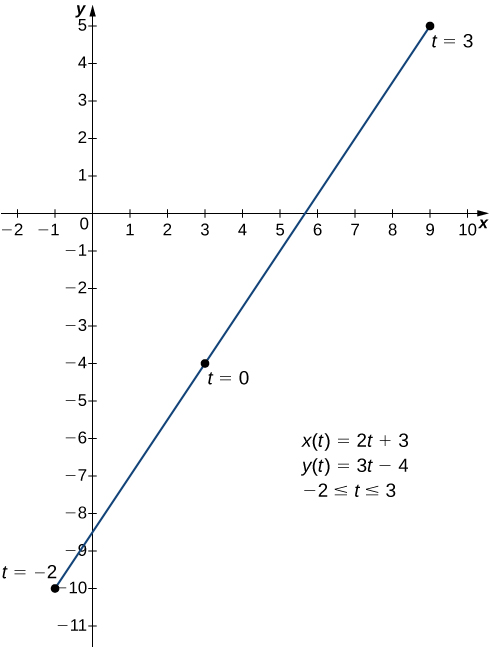
Now that we have introduced the concept of a parameterized curve, our next step is to learn how to work with this concept in the context of calculus. For example, if we know a parameterization of a given curve, is it possible to calculate the slope of a tangent line to the curve? How about the arc length of the curve? Or the area under the curve?
Another scenario: Suppose we would like to represent the location of a baseball after the ball leaves a pitcher’s hand. If the position of the baseball is represented by the plane curve
then we should be able to use calculus to find the speed of the ball at any given time. Furthermore, we should be able to calculate just how far that ball has traveled as a function of time.
We start by asking how to calculate the slope of a line tangent to a parametric curve at a point. Consider the plane curve defined by the parametric equations
The graph of this curve appears in [link]. It is a line segment starting at
and ending at

We can eliminate the parameter by first solving the equation
for t:
Substituting this into
we obtain
The slope of this line is given by
Next we calculate
and
This gives
and
Notice that
This is no coincidence, as outlined in the following theorem.
Consider the plane curve defined by the parametric equations
and
Suppose that
and
exist, and assume that
Then the derivative
is given by
This theorem can be proven using the Chain Rule. In particular, assume that the parameter t can be eliminated, yielding a differentiable function
Then
Differentiating both sides of this equation using the Chain Rule yields
so
But
which proves the theorem.
□
[link] can be used to calculate derivatives of plane curves, as well as critical points. Recall that a critical point of a differentiable function
is any point
such that either
or
does not exist. [link] gives a formula for the slope of a tangent line to a curve defined parametrically regardless of whether the curve can be described by a function
or not.
Calculate the derivative
for each of the following parametrically defined plane curves, and locate any critical points on their respective graphs.
and
Next substitute these into the equation:
This derivative is undefined when
Calculating
and
gives
and
which corresponds to the point
on the graph. The graph of this curve is a parabola opening to the right, and the point
is its vertex as shown.
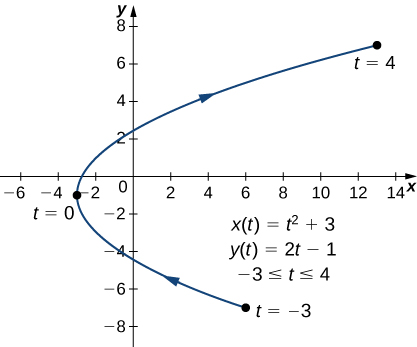
and
Next substitute these into the equation:
This derivative is zero when
When
we have
which corresponds to the point
on the graph. When
we have
which corresponds to the point
on the graph. The point
is a relative minimum and the point
is a relative maximum, as seen in the following graph.
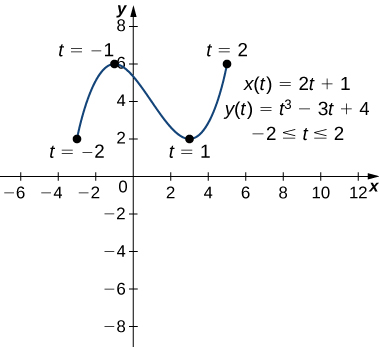
and
Next substitute these into the equation:
This derivative is zero when
and is undefined when
This gives
as critical points for t. Substituting each of these into
and
we obtain
| {: valign=”top”} | ———- | |
| 0 | 5 | 0 |
| {: valign=”top”} |
| 0 | 5 |
| {: valign=”top”} |
| −5 | 0 |
| {: valign=”top”} |
| 0 | −5 |
| {: valign=”top”} |
| 5 | 0 | {: valign=”top”}{: .unnumbered summary=”This table has three columns and six rows. The first row is a header row, and it reads from left to right t, x(t), and y(t). Below the header row, in the first column, the values read 0, π/2, π, 3π/2, and 2π. In the second column, the values read 5, 0, −5, 0, and 5. In the third column, the values read 0, 5, 0, −5, and 0.”}
These points correspond to the sides, top, and bottom of the circle that is represented by the parametric equations ([link]). On the left and right edges of the circle, the derivative is undefined, and on the top and bottom, the derivative equals zero.
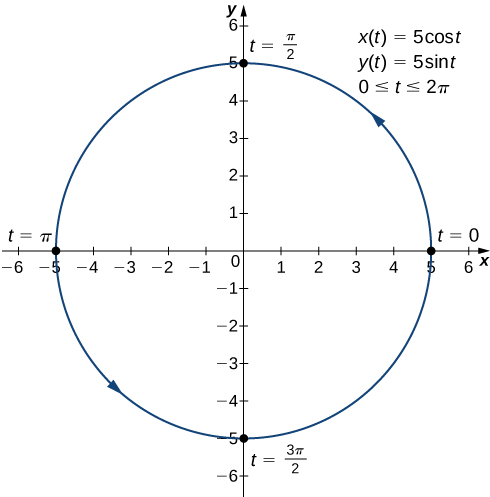
Calculate the derivative
for the plane curve defined by the equations
and locate any critical points on its graph.
and
so
This expression is undefined when
and equal to zero when
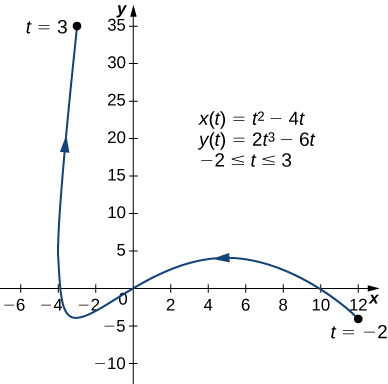
Find the equation of the tangent line to the curve defined by the equations
First find the slope of the tangent line using [link], which means calculating
and
Next substitute these into the equation:
When
so this is the slope of the tangent line. Calculating
and
gives
which corresponds to the point
on the graph ([link]). Now use the point-slope form of the equation of a line to find the equation of the tangent line:
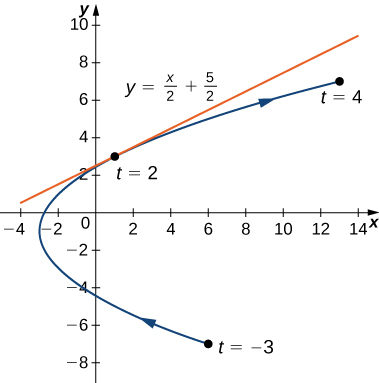
Find the equation of the tangent line to the curve defined by the equations
The equation of the tangent line is
Our next goal is to see how to take the second derivative of a function defined parametrically. The second derivative of a function
is defined to be the derivative of the first derivative; that is,
Since
we can replace the
on both sides of this equation with
This gives us
If we know
as a function of t, then this formula is straightforward to apply.
Calculate the second derivative
for the plane curve defined by the equations
and locate any critical points on its graph.
Critical points
Start with the solution from the previous checkpoint, and use [link].
Now that we have seen how to calculate the derivative of a plane curve, the next question is this: How do we find the area under a curve defined parametrically? Recall the cycloid defined by the equations
Suppose we want to find the area of the shaded region in the following graph.
![Graph of a cycloid with the arch over [0,2π] highlighted. A series of half circles drawn above the x axis with x intercepts being multiples of 2π. The half circle between 0 and 2π is highlighted. On the graph there are also written two equations: x(t) = t – sin(t) and y(t) = 1 – cos(t).](../resources/CNX_Calc_Figure_11_02_007.jpg)
To derive a formula for the area under the curve defined by the functions
we assume that
is differentiable and start with an equal partition of the interval
Suppose
and consider the following graph.
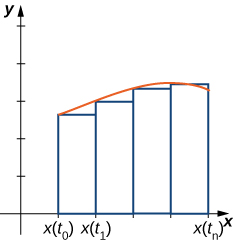
We use rectangles to approximate the area under the curve. The height of a typical rectangle in this parametrization is
for some value
in the ith subinterval, and the width can be calculated as
Thus the area of the ith rectangle is given by
Then a Riemann sum for the area is
Multiplying and dividing each area by
gives
Taking the limit as
approaches infinity gives
This leads to the following theorem.
Consider the non-self-intersecting plane curve defined by the parametric equations
and assume that
is differentiable. The area under this curve is given by
Find the area under the curve of the cycloid defined by the equations
Using [link], we have
Find the area under the curve of the hypocycloid defined by the equations
(Note that the integral formula actually yields a negative answer. This is due to the fact that
is a decreasing function over the interval
that is, the curve is traced from right to left.)
In addition to finding the area under a parametric curve, we sometimes need to find the arc length of a parametric curve. In the case of a line segment, arc length is the same as the distance between the endpoints. If a particle travels from point A to point B along a curve, then the distance that particle travels is the arc length. To develop a formula for arc length, we start with an approximation by line segments as shown in the following graph.
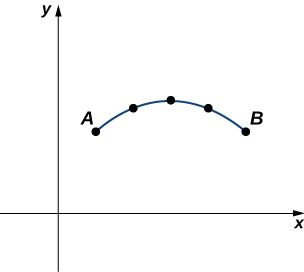
Given a plane curve defined by the functions
we start by partitioning the interval
into n equal subintervals:
The width of each subinterval is given by
We can calculate the length of each line segment:
Then add these up. We let s denote the exact arc length and
denote the approximation by n line segments:
If we assume that
and
are differentiable functions of t, then the Mean Value Theorem (Introduction to the Applications of Derivatives) applies, so in each subinterval
there exist
and
such that
Therefore [link] becomes
This is a Riemann sum that approximates the arc length over a partition of the interval
If we further assume that the derivatives are continuous and let the number of points in the partition increase without bound, the approximation approaches the exact arc length. This gives
When taking the limit, the values of
and
are both contained within the same ever-shrinking interval of width
so they must converge to the same value.
We can summarize this method in the following theorem.
Consider the plane curve defined by the parametric equations
and assume that
and
are differentiable functions of t. Then the arc length of this curve is given by
At this point a side derivation leads to a previous formula for arc length. In particular, suppose the parameter can be eliminated, leading to a function
Then
and the Chain Rule gives
Substituting this into [link] gives
Here we have assumed that
which is a reasonable assumption. The Chain Rule gives
and letting
and
we obtain the formula
which is the formula for arc length obtained in the Introduction to the Applications of Integration.
Find the arc length of the semicircle defined by the equations
We now return to the problem posed at the beginning of the section about a baseball leaving a pitcher’s hand. Ignoring the effect of air resistance (unless it is a curve ball!), the ball travels a parabolic path. Assuming the pitcher’s hand is at the origin and the ball travels left to right in the direction of the positive x-axis, the parametric equations for this curve can be written as
where t represents time. We first calculate the distance the ball travels as a function of time. This distance is represented by the arc length. We can modify the arc length formula slightly. First rewrite the functions
and
using v as an independent variable, so as to eliminate any confusion with the parameter t:
Then we write the arc length formula as follows:
The variable v acts as a dummy variable that disappears after integration, leaving the arc length as a function of time t. To integrate this expression we can use a formula from Appendix A,
We set
and
This gives
so
Therefore
and
This function represents the distance traveled by the ball as a function of time. To calculate the speed, take the derivative of this function with respect to t. While this may seem like a daunting task, it is possible to obtain the answer directly from the Fundamental Theorem of Calculus:
Therefore
One third of a second after the ball leaves the pitcher’s hand, the distance it travels is equal to
This value is just over three quarters of the way to home plate. The speed of the ball is
This speed translates to approximately 95 mph—a major-league fastball.
Recall the problem of finding the surface area of a volume of revolution. In Curve Length and Surface Area, we derived a formula for finding the surface area of a volume generated by a function
from
to
revolved around the x-axis:
We now consider a volume of revolution generated by revolving a parametrically defined curve
around the x-axis as shown in the following figure.
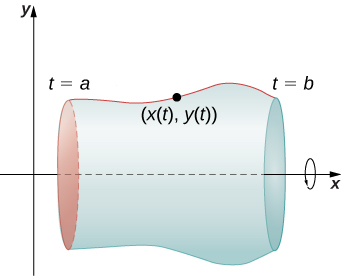
The analogous formula for a parametrically defined curve is
provided that
is not negative on
Find the surface area of a sphere of radius r centered at the origin.
We start with the curve defined by the equations
This generates an upper semicircle of radius r centered at the origin as shown in the following graph.
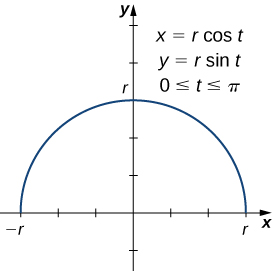
When this curve is revolved around the x-axis, it generates a sphere of radius r. To calculate the surface area of the sphere, we use [link]:
This is, in fact, the formula for the surface area of a sphere.
Find the surface area generated when the plane curve defined by the equations
is revolved around the x-axis.
Use [link]. When evaluating the integral, use a u-substitution.
and
can be calculated using the formula
Using the derivative, we can find the equation of a tangent line to a parametric curve.
If the curve is revolved around the y-axis, then the formula is
For the following exercises, each set of parametric equations represents a line. Without eliminating the parameter, find the slope of each line.
0
For the following exercises, determine the slope of the tangent line, then find the equation of the tangent line at the given value of the parameter.
Slope is undefined;
For the following exercises, find all points on the curve that have the given slope.
slope = 0.5
No points possible; undefined expression.
For the following exercises, write the equation of the tangent line in Cartesian coordinates for the given parameter t.
For
where
Find all values of t at which a horizontal tangent line exists.
For
where
Find all values of t at which a vertical tangent line exists.
Find all points on the curve
that have the slope of
Find
for
Find the equation of the tangent line to
at
For the curve
find the slope and concavity of the curve at
and
so the curve is neither concave up nor concave down at
Therefore the graph is linear and has a constant slope but no concavity.
For the parametric curve whose equation is
find the slope and concavity of the curve at
Find the slope and concavity for the curve whose equation is
at
the curve is concave down at
Find all points on the curve
at which there are vertical and horizontal tangents.
Find all points on the curve
at which horizontal and vertical tangents exist.
No horizontal tangents. Vertical tangents at
For the following exercises, find
For the following exercises, find points on the curve at which tangent line is horizontal or vertical.
Horizontal
vertical
For the following exercises, find
at the value of the parameter.
1
0
For the following exercises, find
at the given point without eliminating the parameter.
4
Find t intervals on which the curve
is concave up as well as concave down.
Determine the concavity of the curve
Concave up on
Sketch and find the area under one arch of the cycloid
Find the area bounded by the curve
and the lines
and
1
Find the area enclosed by the ellipse
Find the area of the region bounded by
for
For the following exercises, find the area of the regions bounded by the parametric curves and the indicated values of the parameter.
[T]
[T]
(the “hourglass”)
[T]
(the “teardrop”)
For the following exercises, find the arc length of the curve on the indicated interval of the parameter.
(express answer as a decimal rounded to three places)
on the interval
(the hypocycloid)
Find the length of one arch of the cycloid
Find the distance traveled by a particle with position
as t varies in the given time interval:
Find the length of one arch of the cycloid
Show that the total length of the ellipse
is
where
and
Find the length of the curve
For the following exercises, find the area of the surface obtained by rotating the given curve about the x-axis.
[T] Use a CAS to find the area of the surface generated by rotating
about the x-axis. (Answer to three decimal places.)
59.101
Find the surface area obtained by rotating
about the y-axis.
Find the area of the surface generated by revolving
about the x-axis.
Find the surface area generated by revolving
about the y-axis.

You can also download for free at http://cnx.org/contents/9a1df55a-b167-4736-b5ad-15d996704270@5.1
Attribution: